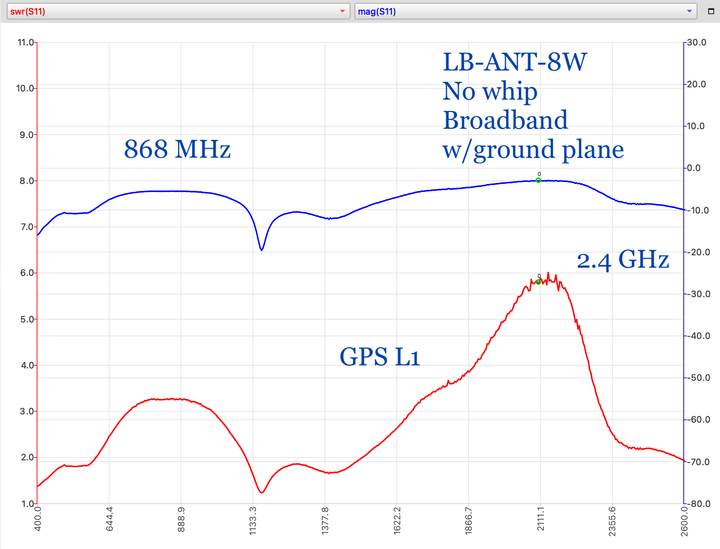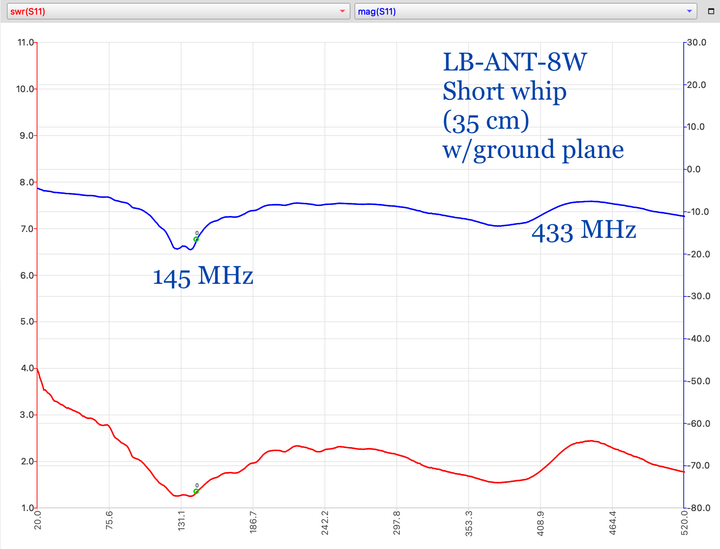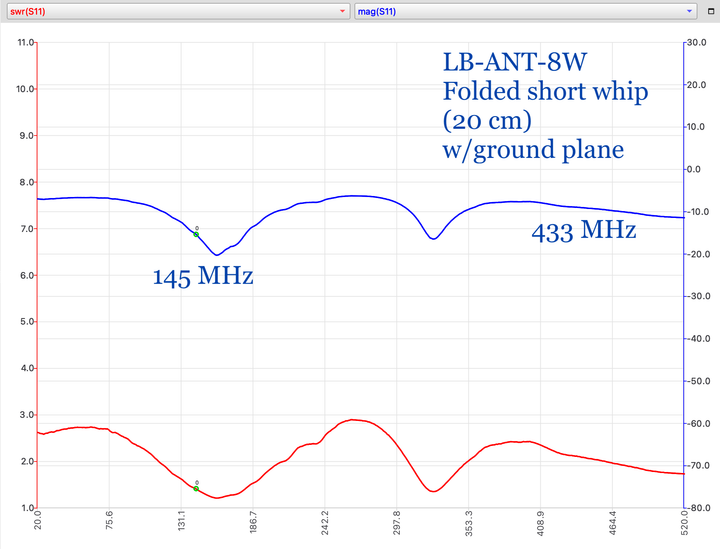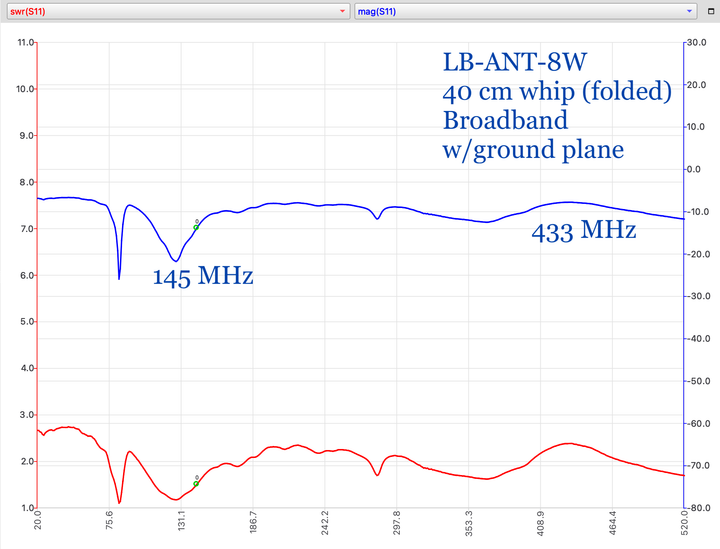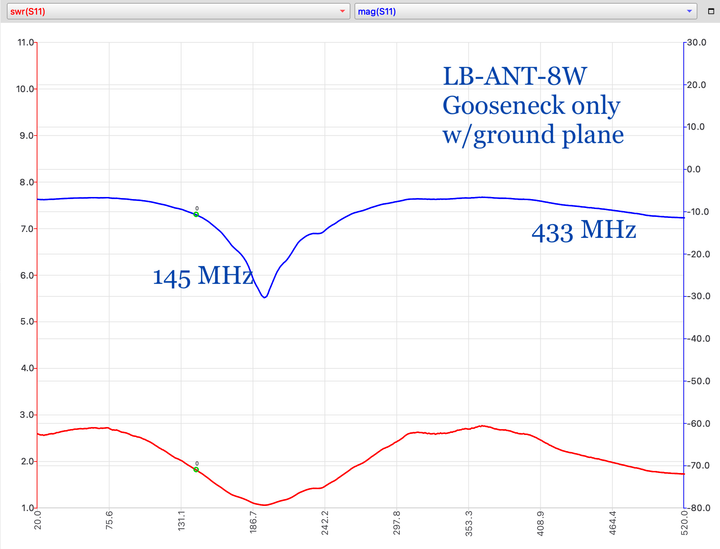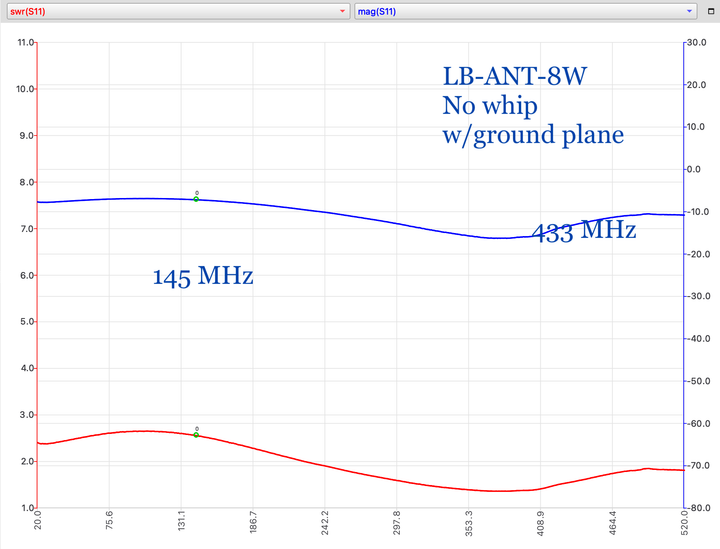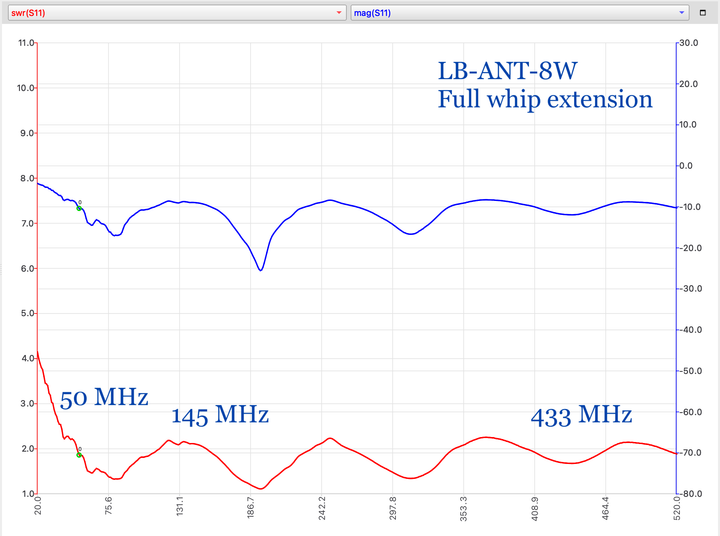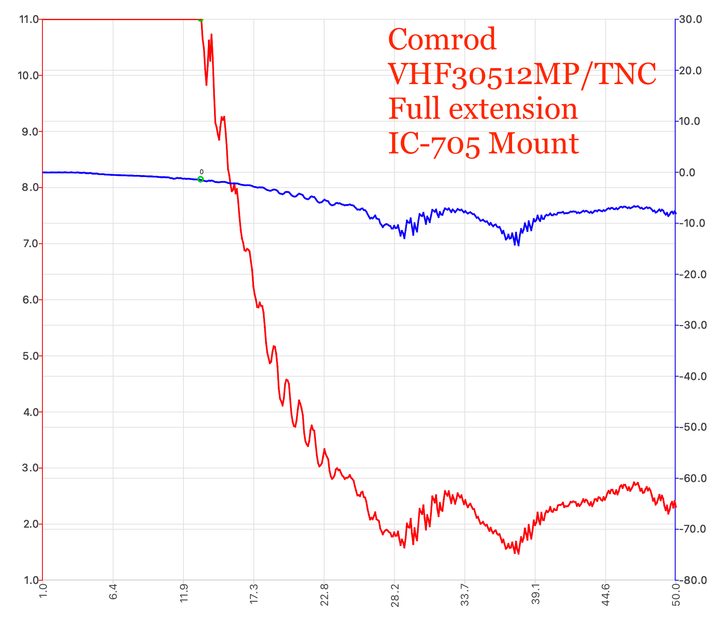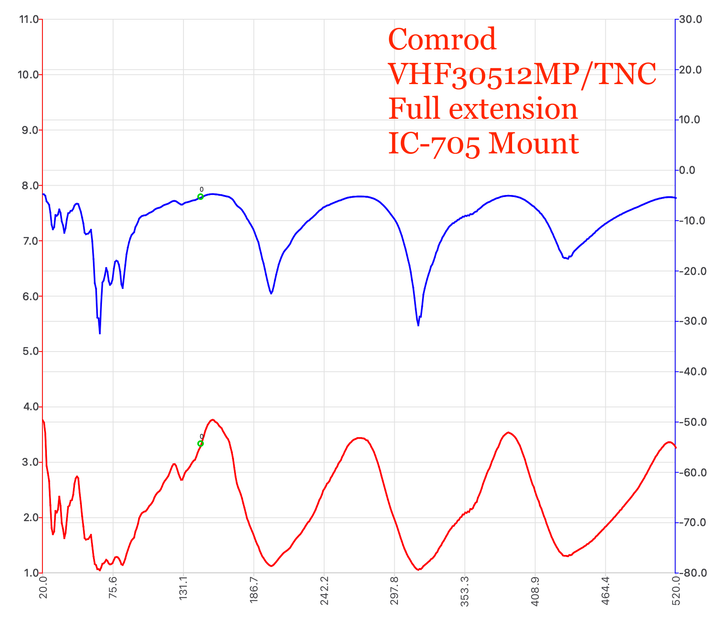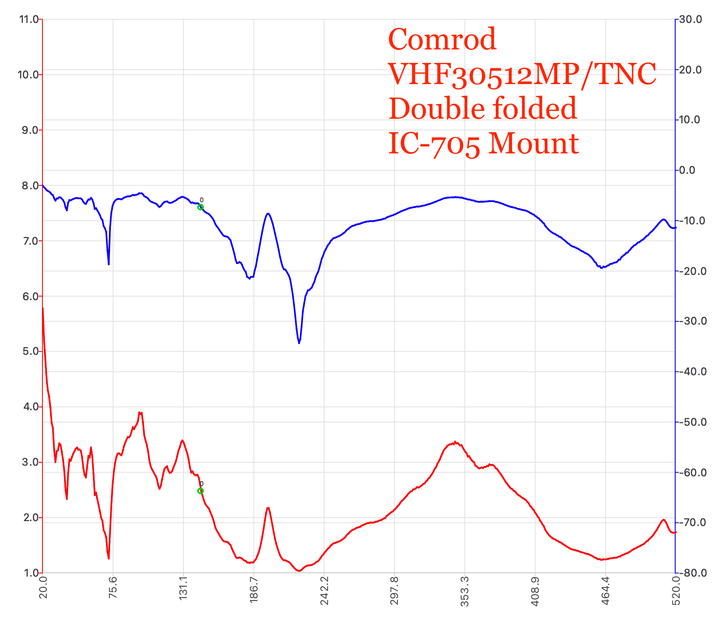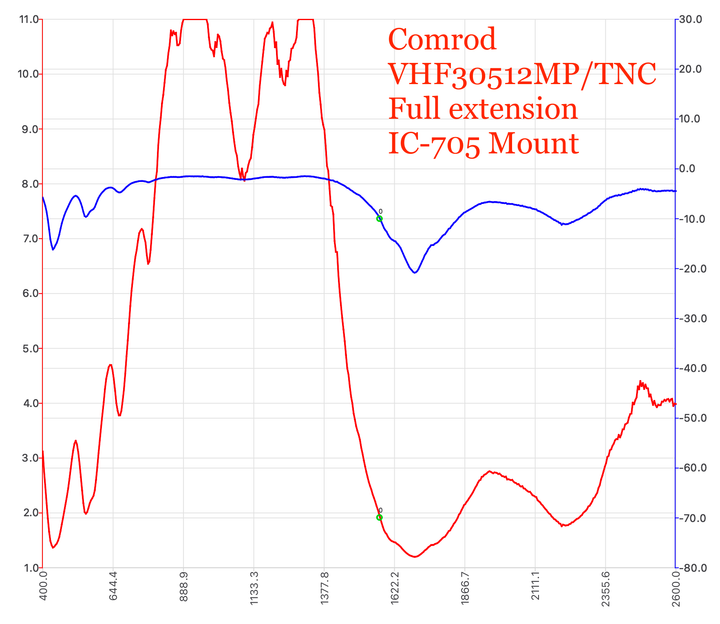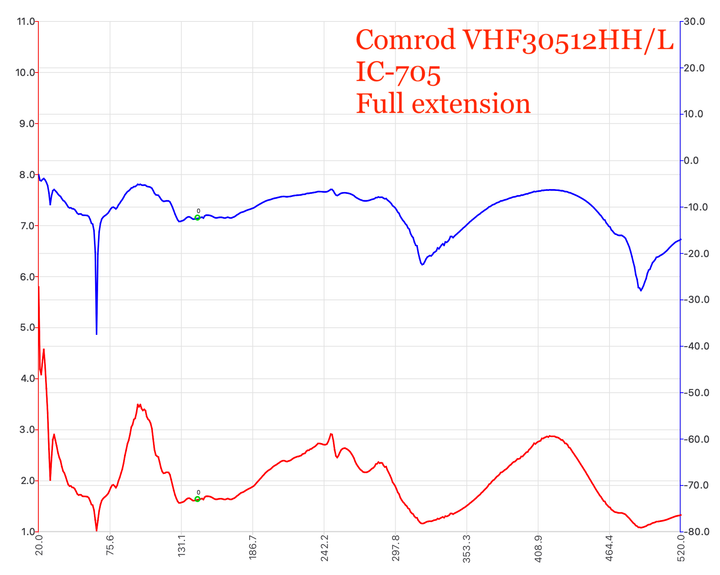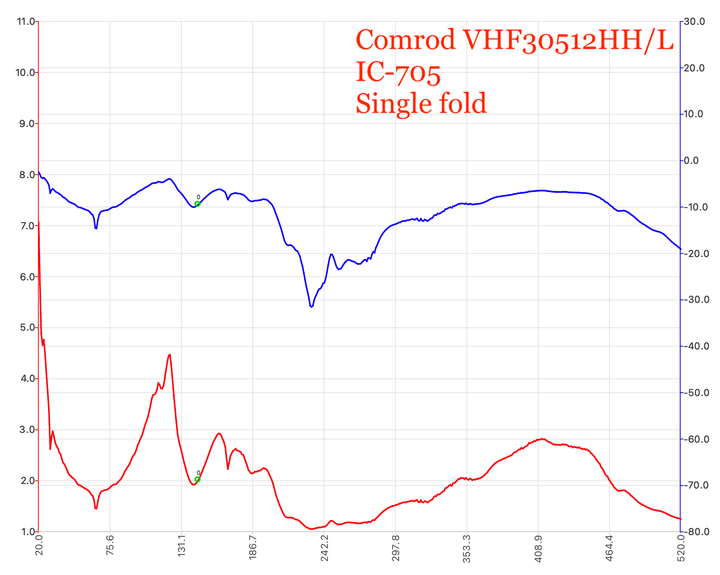Wideband Antennas — S11 Measurements

This is my collection of SWR measurements of various antennas I've bought, partially just to keep them somewhere I can find them.
This article will likely be updated as I acquire new antennas to test.
Table of Contents
This set of measurements was performed on a nanoVNA V2 using a minimal ground plane to simulate a hand held device. I decided to touch the ground plane to extend it for some antennas, since they performed significantly better this way.
My goal is to determine optimal antennas to use for a combination of fixed install and portable use, to cover the range of 433, 868, GPS L1, and 2.4 GHz.
Additionally, I am interested in VHF/UHF antennas to cover ideally 100-500 MHz, preferably continuously.
5G/IoT Antennas
Summary
The Taoglas Apex IV is the only choice if you need 433 MHz, and it's competent otherwise.
The Pulse W5084K is probably the best over all portable antenna in this category, with better than 2:1 SWR across the board.
The 2J "Dagger" is also a good option given the performance to size ratio.
For fixed install the Laird TRA806/17103P is a really good option when given a bit of ground plane.
Taoglas TG.46.8113 Apex IV
This antenna is specified for 410-450 MHz as well as the usual ~700-6000 MHz range.
It performs with around 2:1 SWR in the 70 cm band when provided with a little ground plane, decent 868/915 MHz, and very nice GPS and Wi-Fi performance. It's pretty big.
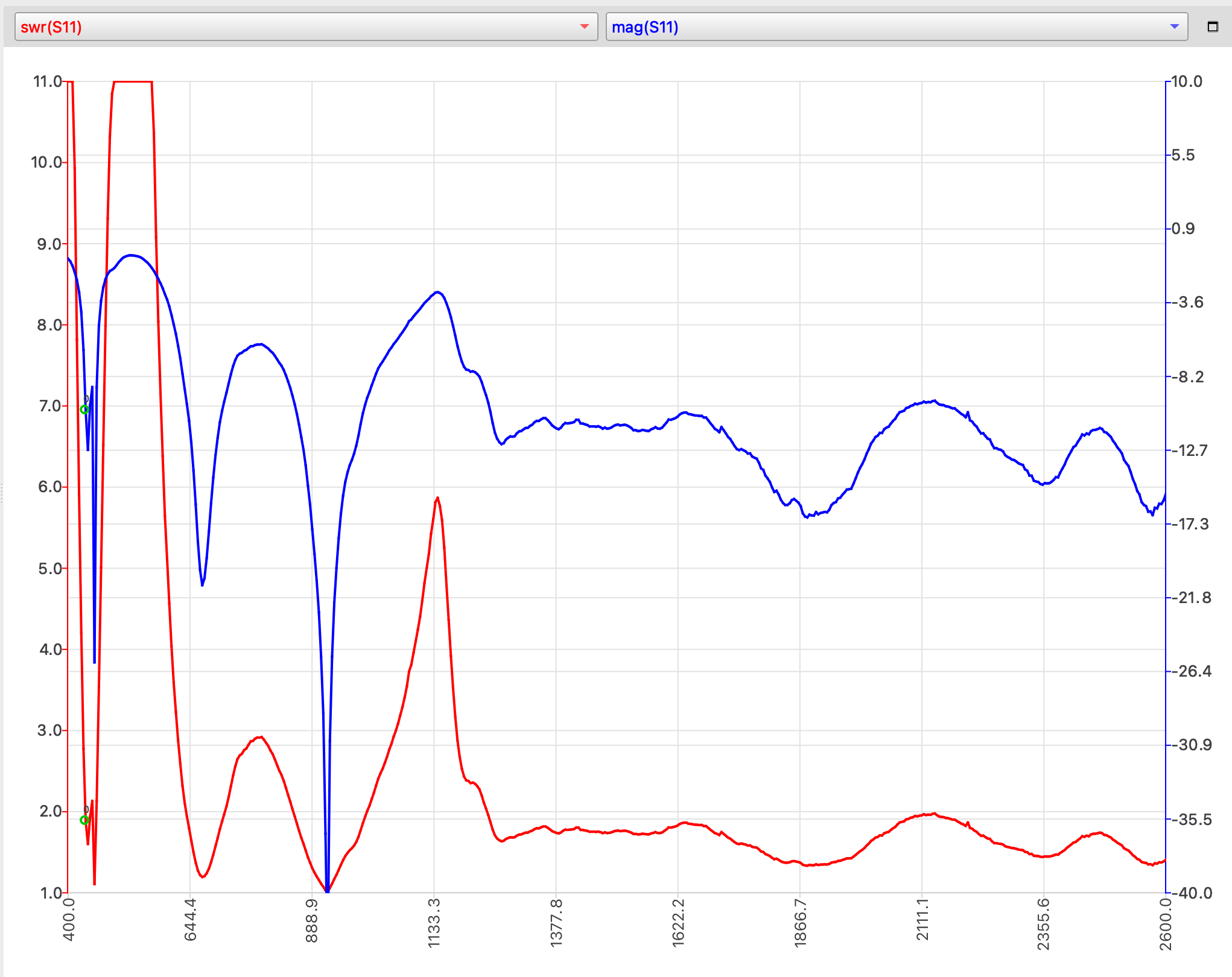
Pulse W5084K
This is a similar antenna to the Taoglas above, but it lacks the 70 cm band. It's shaped like a lollipop!
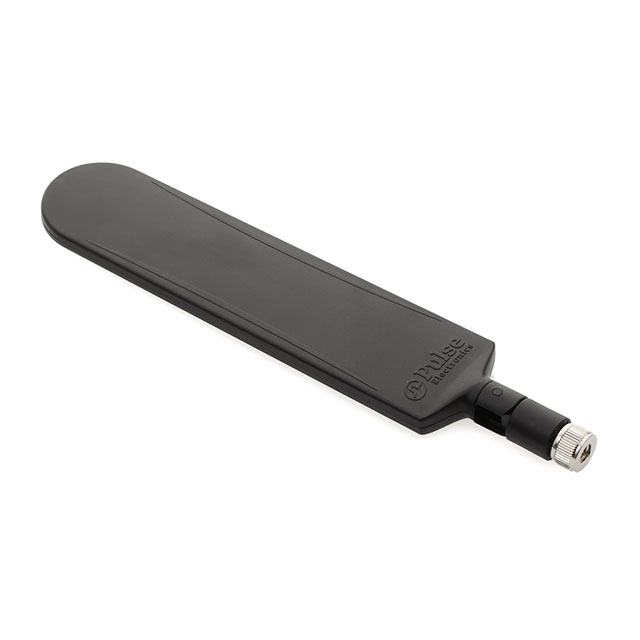
The antenna looks messier, but has decent 868, GPS, and excellent Wi-Fi.
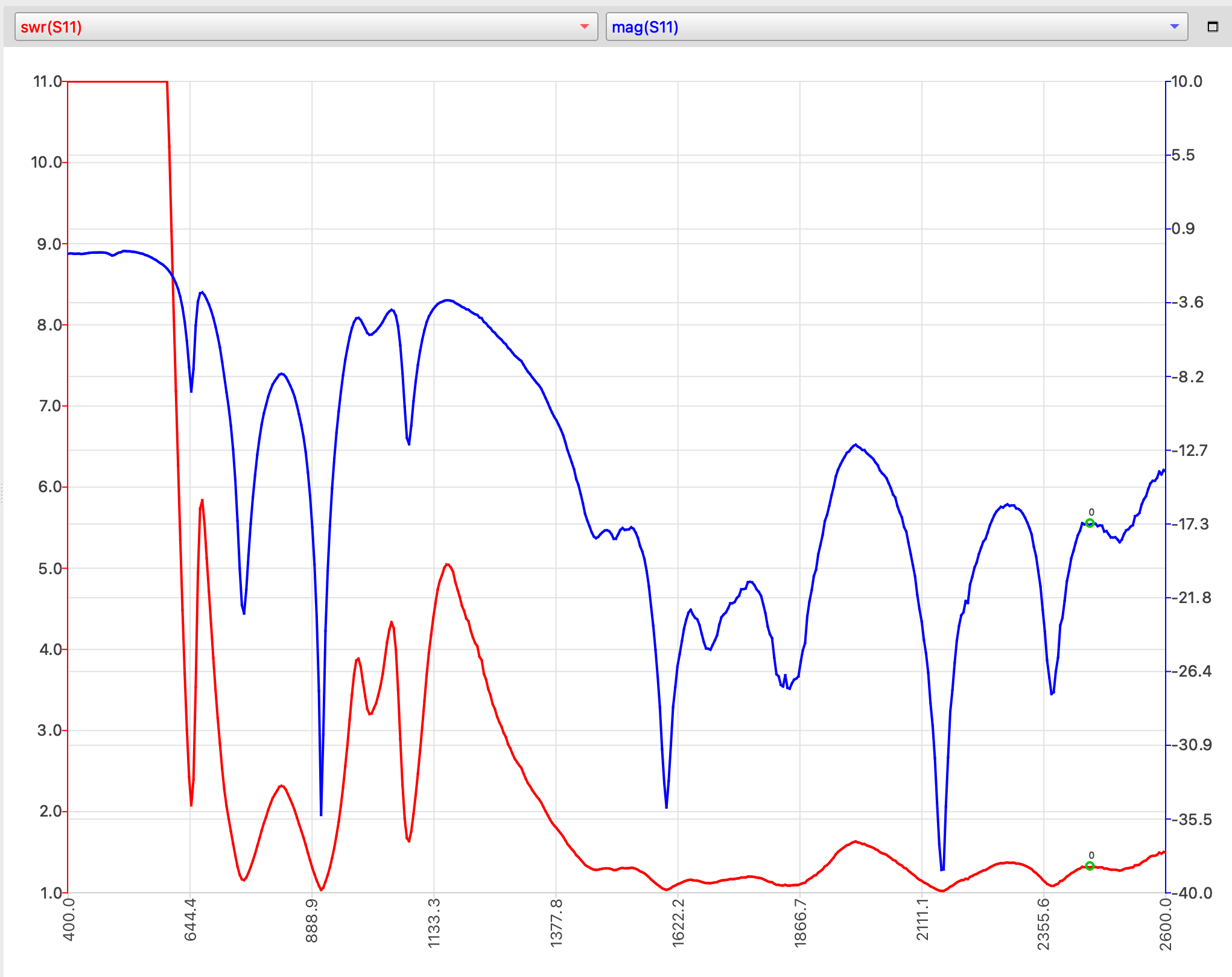
2J Antennas 2JW1483 "Dagger"
The only whip antenna in its class for the initial tests, this antenna looks really nice and feels pretty solid. It offers borderline 868 performance, decent GPS, and excellent Wi-Fi.
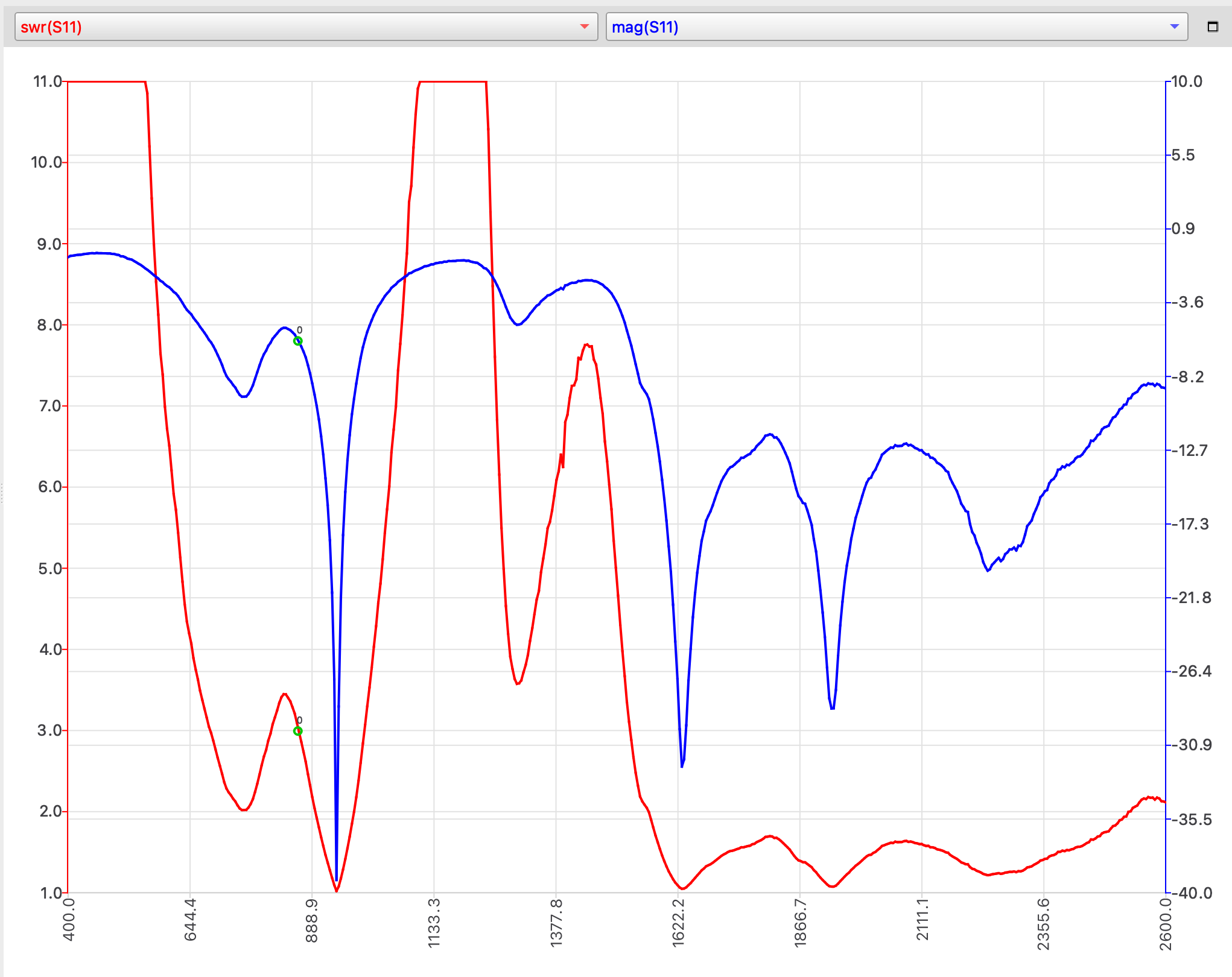
TE/Laird DBA6171C3-BSMAM
A smaller antenna than the two above, this antenna is not very good below 1 GHz. Usable for GPS and Wi-Fi, not particularly good at 868.
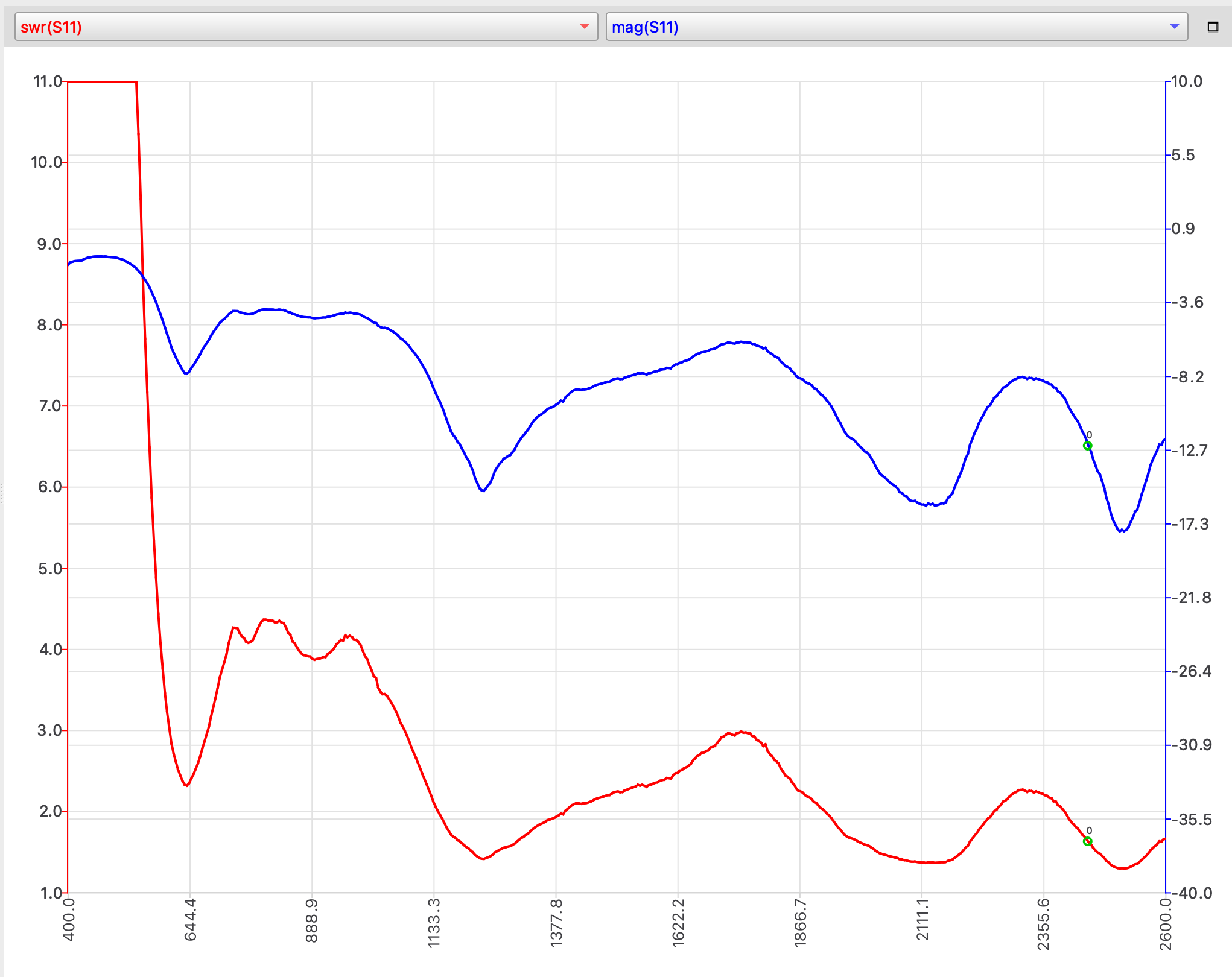
TE/Laird TRA806/17103P
This is a fixed install version of the NMO antenna, it's part of the "Phantom" series of dome-antennas commonly seem on public service vehicles. It's pretty heavy for the small size, and performs really well!
The test was performed with a hand on the ground plane, this dramatically improves 868 performance. My SWR plot looks quite similar to the datasheet one.
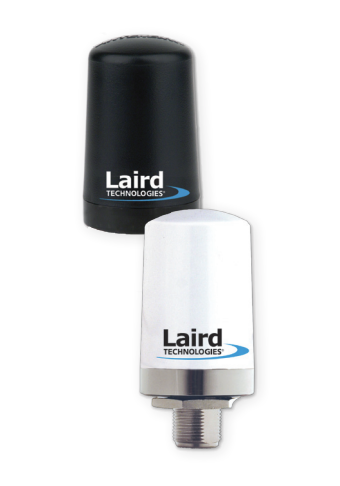
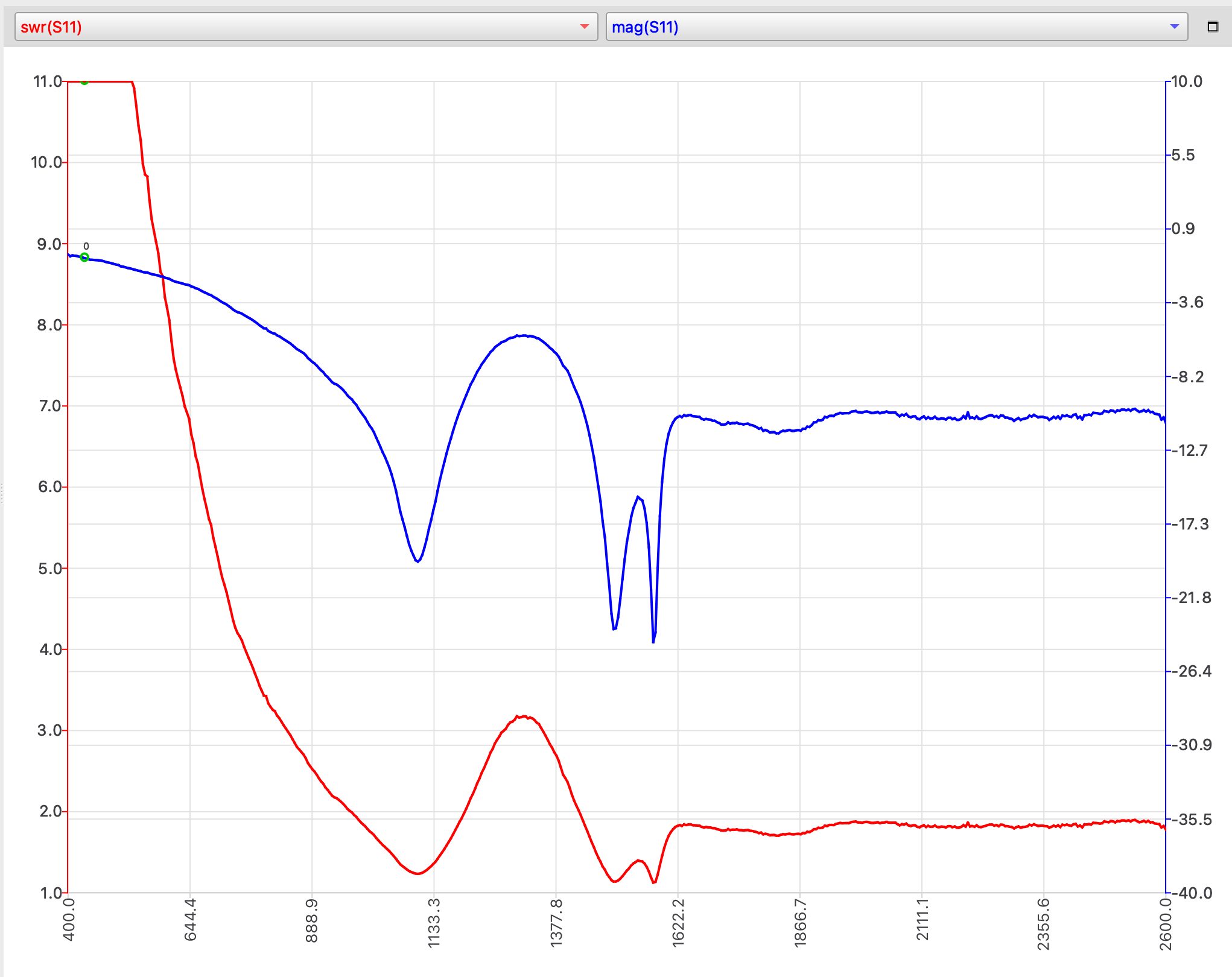
Gizont 5G Gooseneck
This is a large gooseneck antenna marketed as covering 600 MHz and up. It has a very poor performance in the lower end, and smooths out later.
Not a great choice over all.
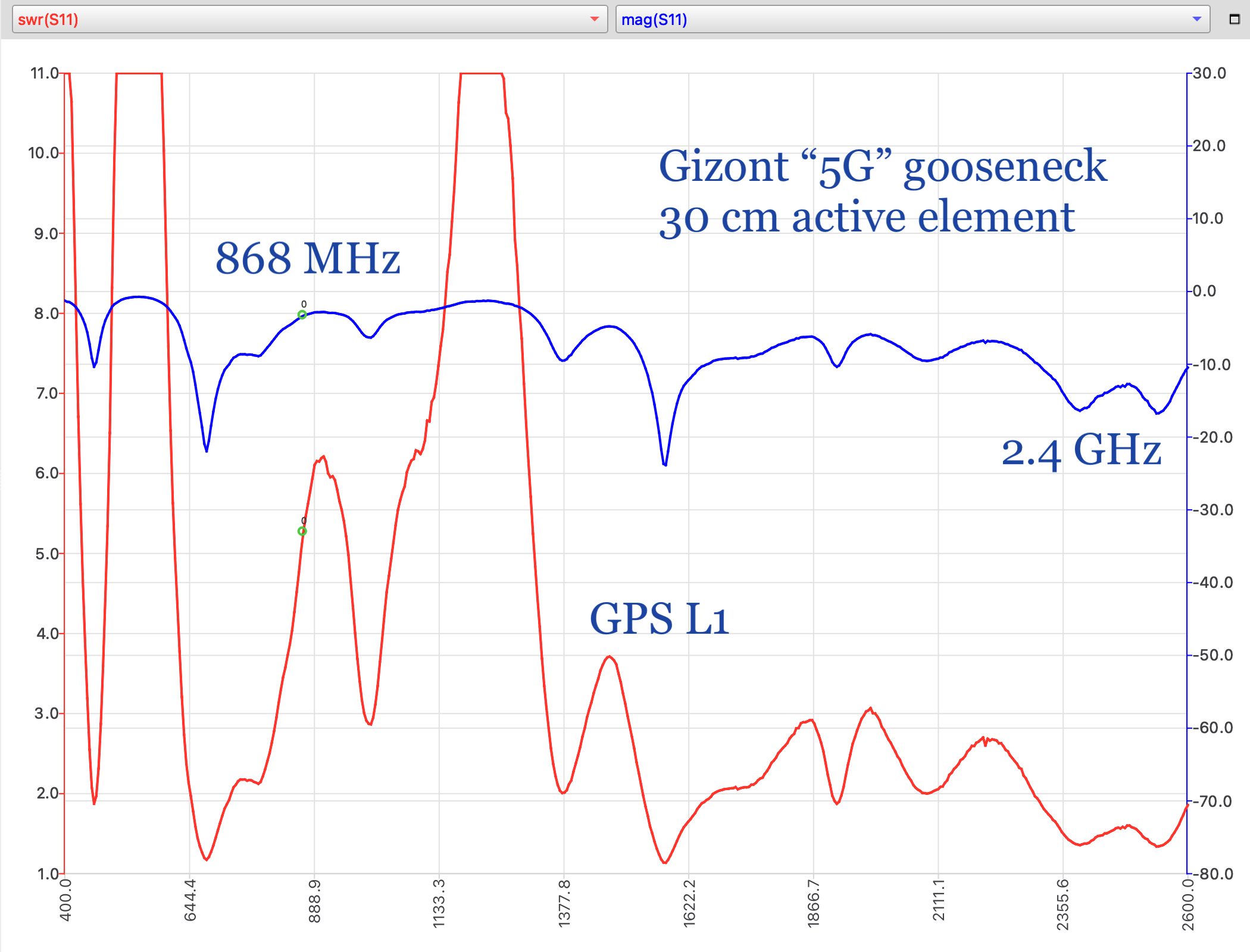
VHF/UHF Antennas
For VHF/UHF antennas we do have to consider that the minimal ground plane will affect the performance. Further, narrow-band antennas are prone to shifting their resonant frequency by quite a lot depending on installation.
I later repeated some tests with a ~40x20 cm aluminium ground plane, these are marked as such below. For the Comrod antennas below I use an IC-705 with a Windcamp cage and a custom alu. plate as a mount.
Summary
The TCA VHF/UHF goosenecks are good choices, the VHF one does seem like it could be used at low power as a dual-band antenna.
If you can get a Comrod, Radiall, or genuine Harris then these antennas do offer good SWR but lossy matching over a very wide range. Generally a bigger antenna will perform better in this domain.
TCA VHF & UHF Goosenecks
These gooseneck antennas can be found on AliExpress, they have a relatively thick whip section (~⌀20 mm). They perform relatively well given their size, the VHF one can almost be used as a dual band antenna.
Not sure why this antenna performed so poorly on the second attempt.
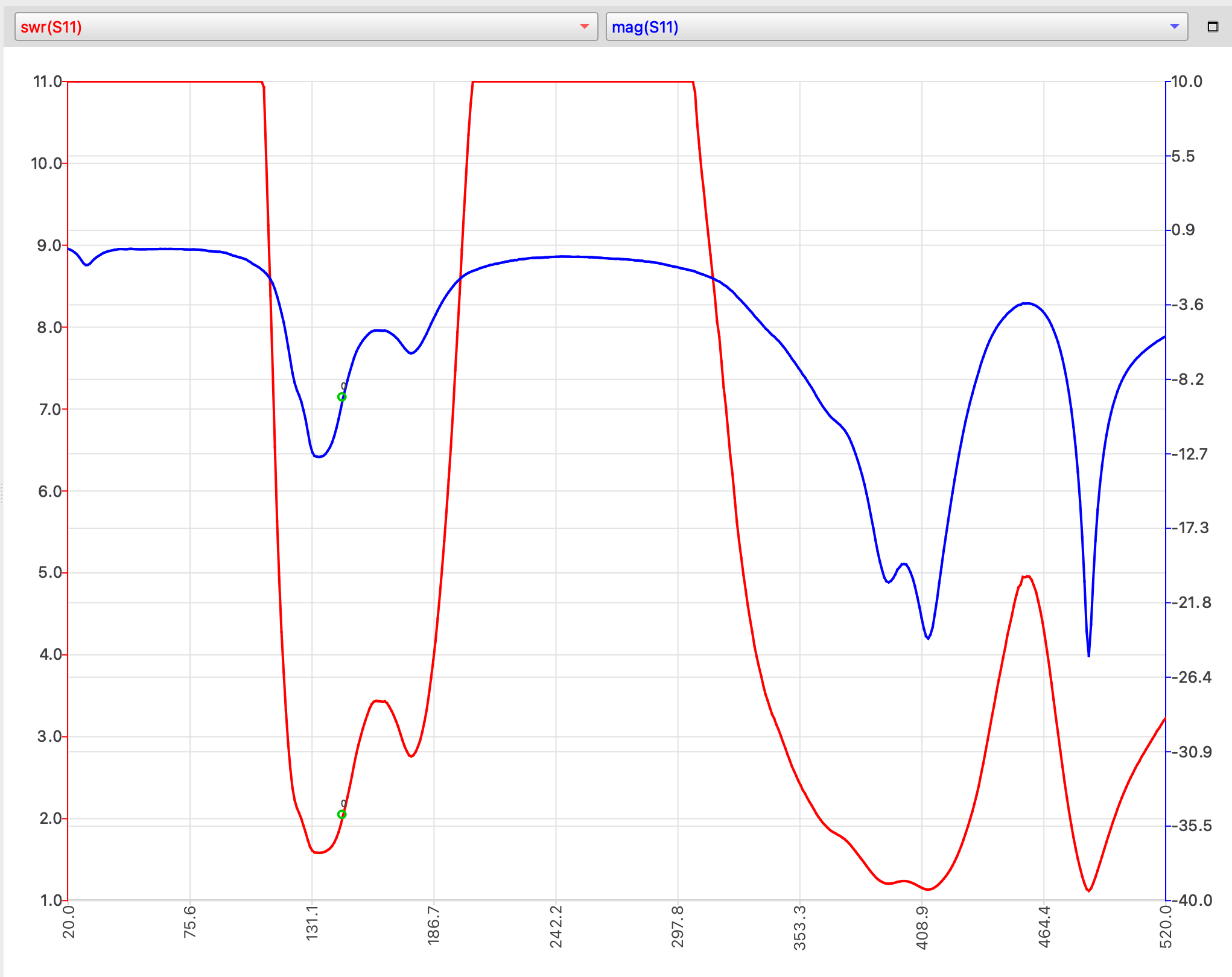
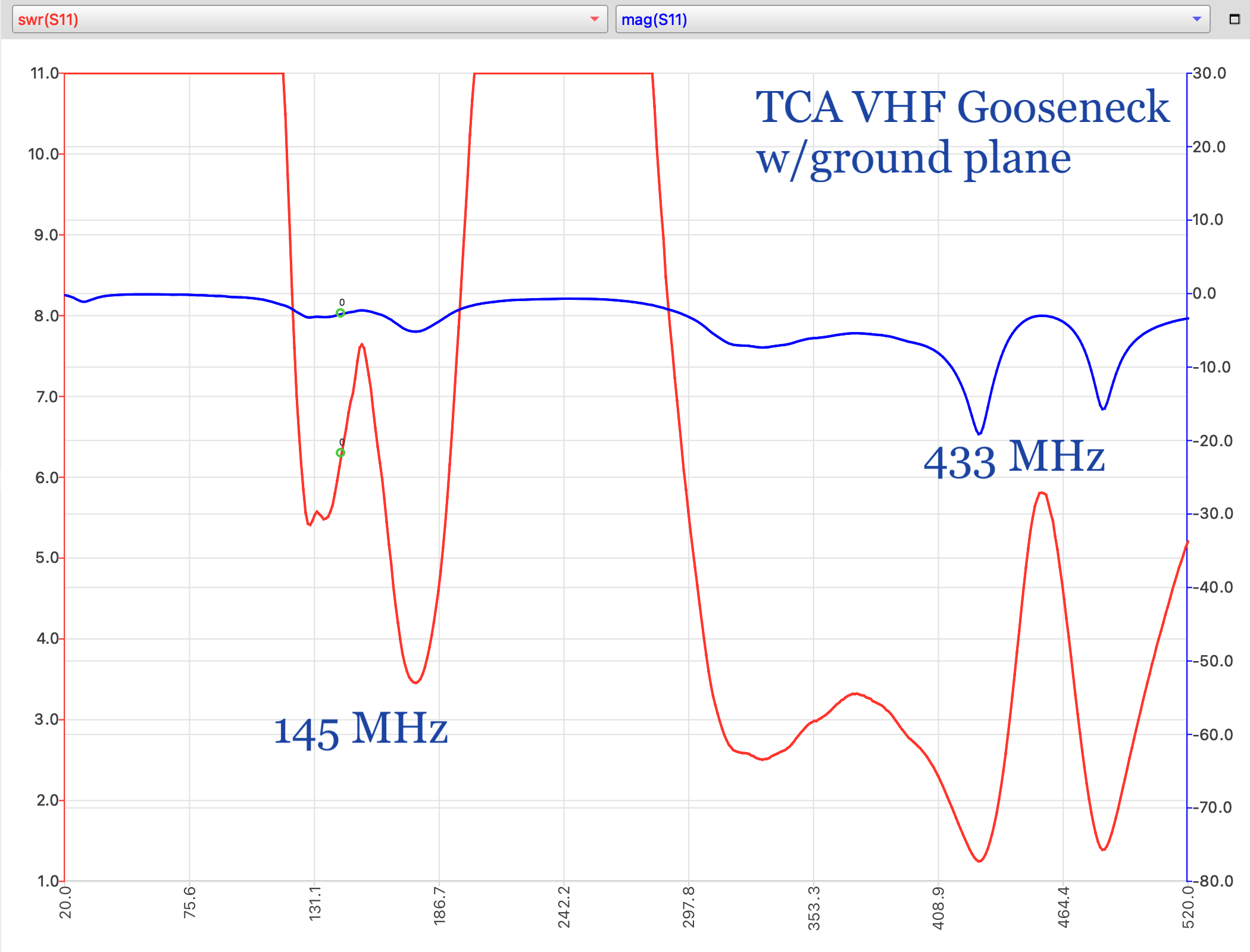
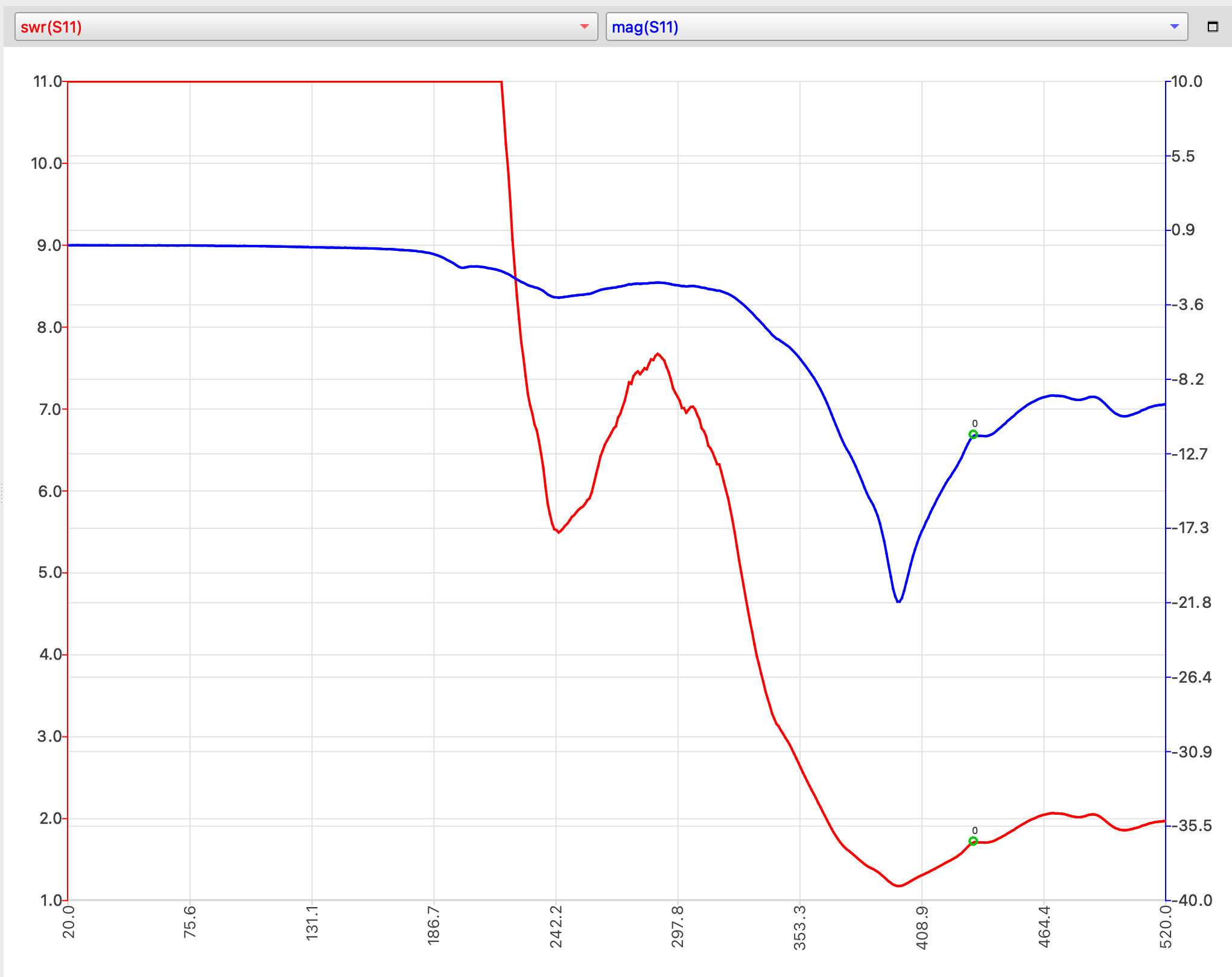
Triumph PRC-152 Whip
This 33 cm long whip is the standard antenna for the TRI AN/PRC-152 as supplied in 2023.
It's not amazing, but it looks like an attempt at covering the intended range (136-174, 220, 420-440) was made.
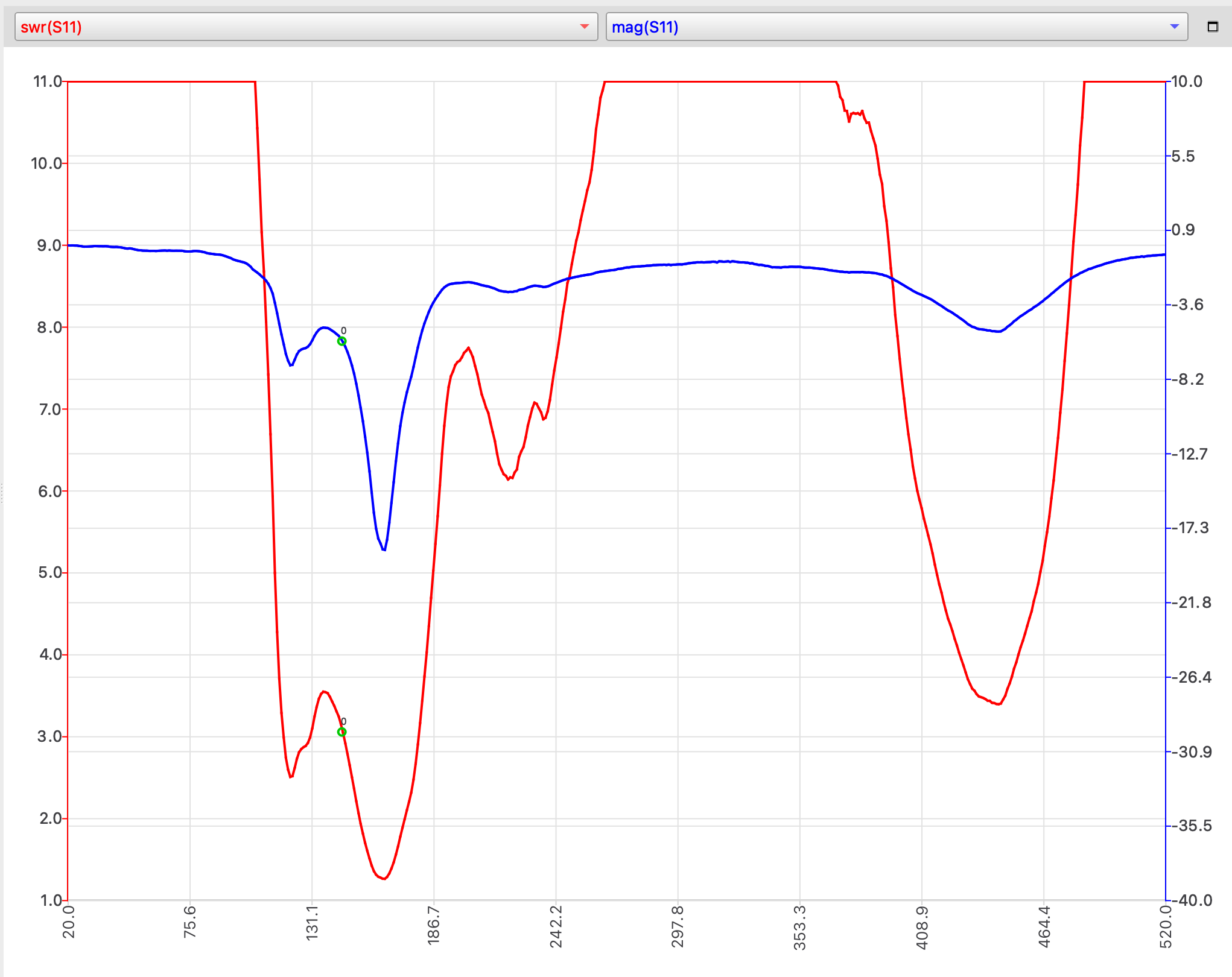
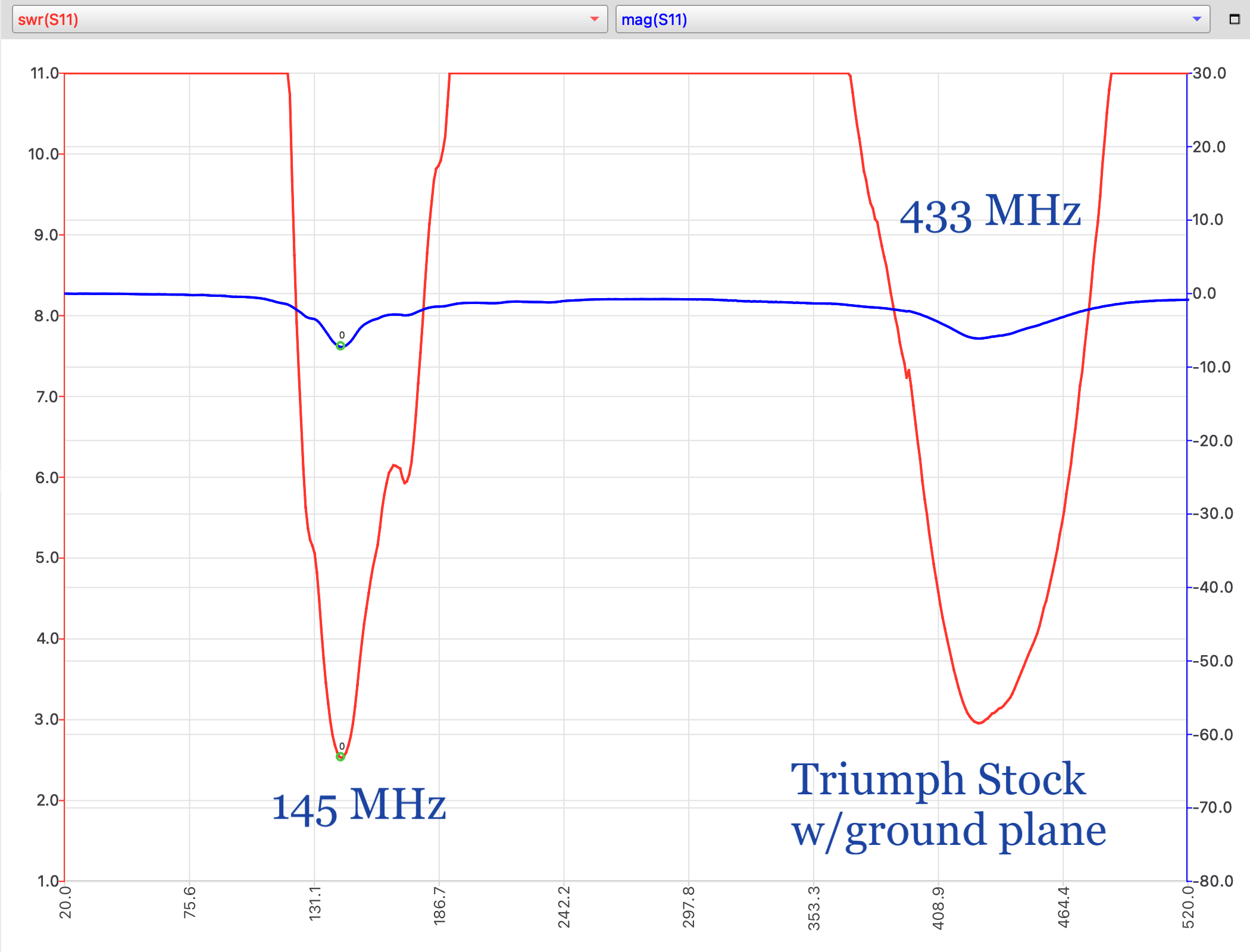
Unknown, ANT.BROADBAND 90-512 MHz
This TNC antenna is marketed as being for the PRC-148. It's better than the Triump one above, having a more wide-band but poor match across most of the specified range.
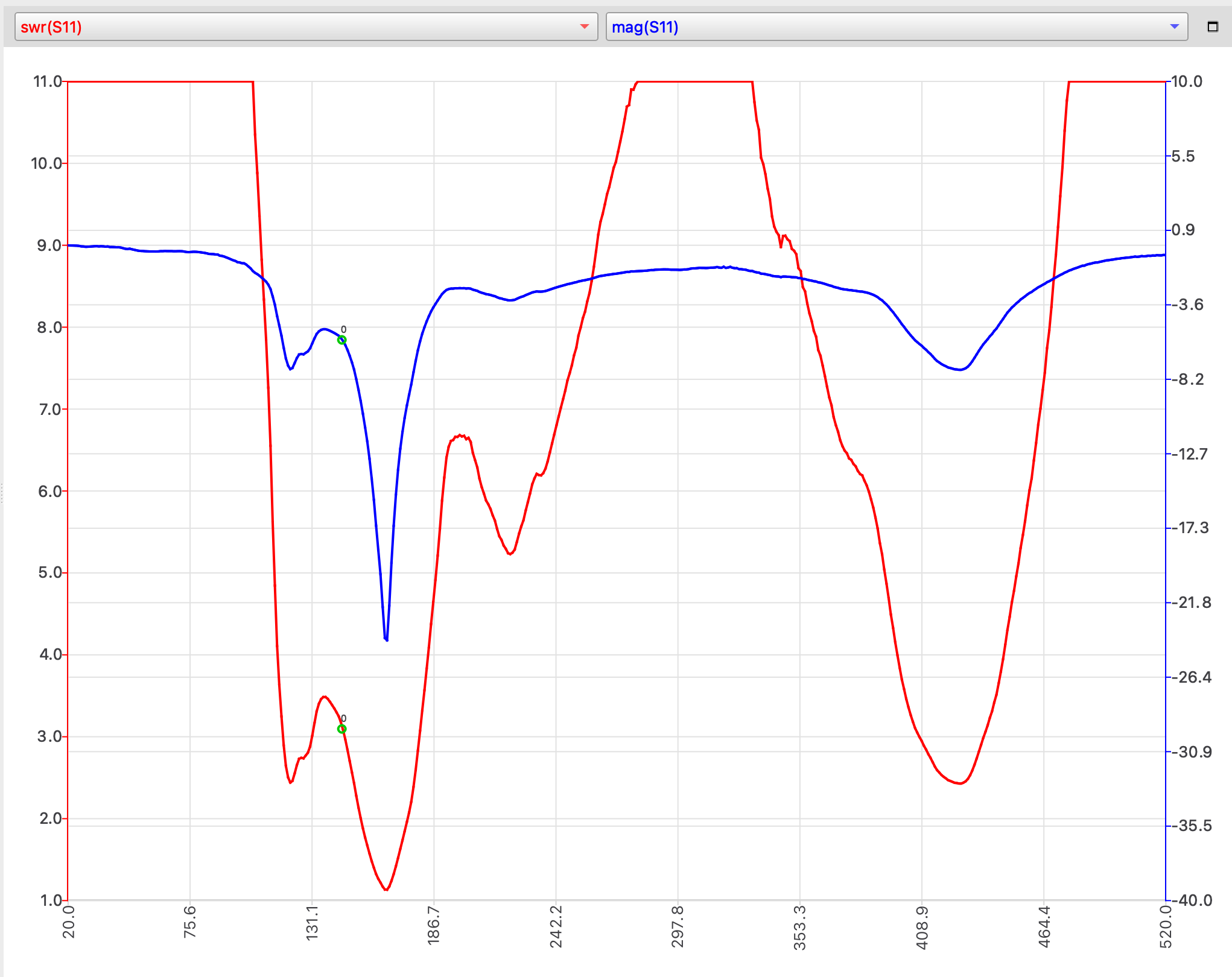
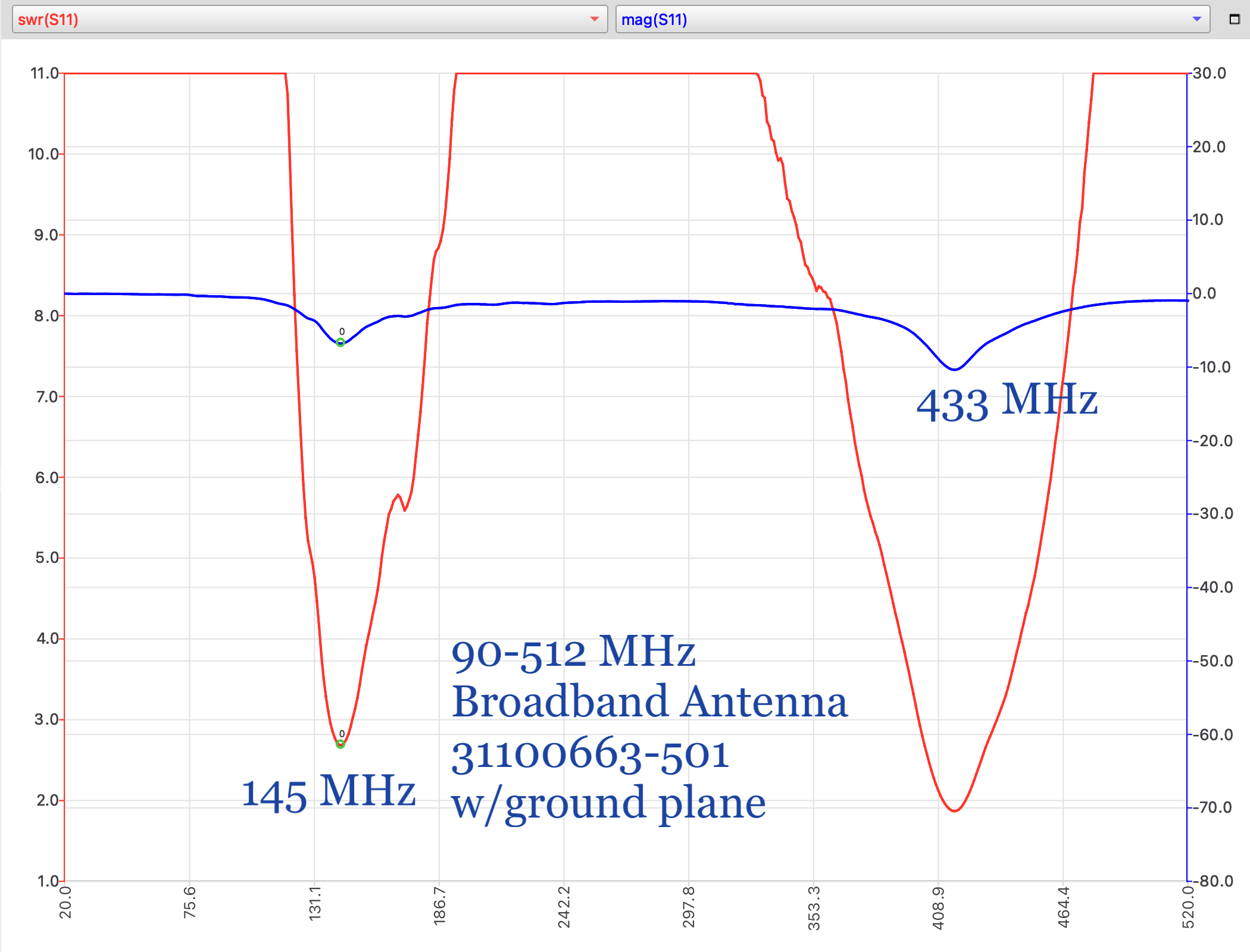
20 cm long gooseneck
This gooseneck antenna has a 20 cm long fiber-glass whip section and is marketed for 144/430 MHz operation. No real change when a ground plane is added.
It's got relatively sharp match in the 150 MHz range, and a very broad-band match from around 300-470 MHz. Not the worst thing I've seen but poor on VHF.
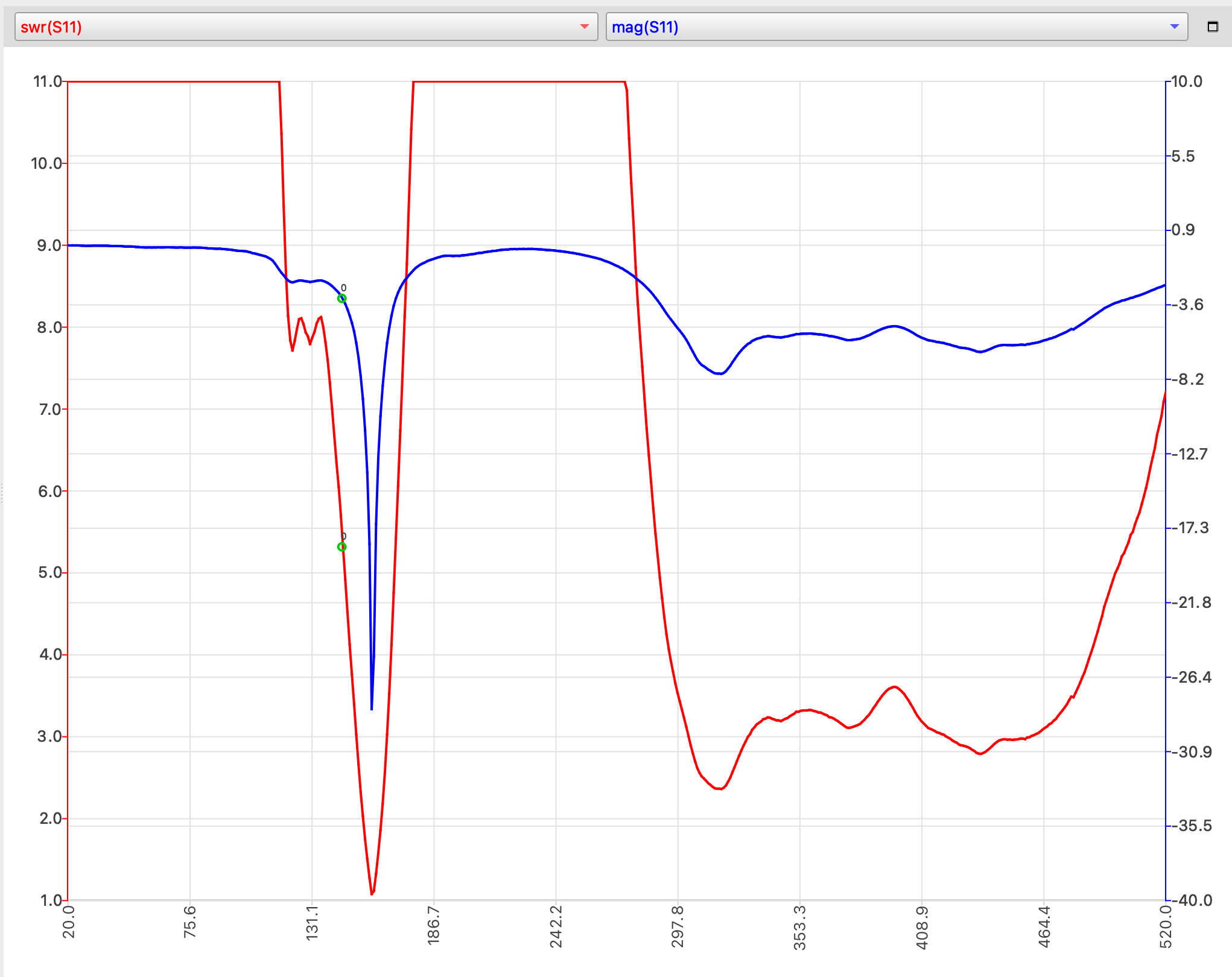
LB-ANT-8W (Harris clone)
This is a clone of a Harris manpack antenna, the typical blade one. I did a couple of tests with this one. I believe this one is made by Triumph.
The markings are "LB-ANT-8W", P/N RF-3152-AT152, which is a real P/N but is not a 30-512 MHz antenna. I think the 8W suffix indicates this is an 8 W rated antenna. The antenna as mentioned is really meant for a manpack, but removing the gooseneck makes it slightly more practical as a portable antenna.
It has good matching across a wide range, but the second plot shows what it looks like without the blade attached at all, I'd wager the matching unit gets pretty warm.
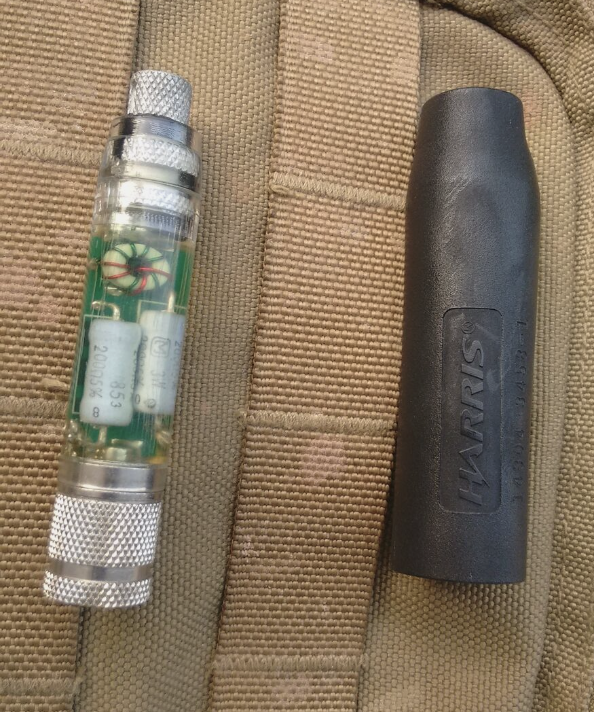
Above a picture of the matching unit for the specific clone antenna I tested shows what I believe is a 1:9 UnUn transformer and a couple of dummy resistors. The antenna reads as a slightly reactive 100 Ω down to around 5 MHz, see Appendix A for the reason. It is surprisingly usable as an SWL antenna.
"LB-ANT"
I purchased what I thought was another LB-ANT-8W in May 2024. Several differences were noted:
- For clarity: the item listing did show what I received, though some photos in the listing appeared to be of other variants of the antenna including the one received previously.
- Marked as a 136-480 MHz antenna instead of 30-512 MHz
- Matching unit seems to be a cast plastic piece instead of the lathe turned plastic of the previous unit
- No Harris™ logo
- If there is anything inside it's not the wide-band match design, since it has very poor SWR with no whip attached
- Performance at 400+ MHz seemed pretty poor
- The screws used on the previous unit were ¼" with a thread pitch close to 1 mm (probably ¼"-24)
- The new unit seems to use M6x1 screws instead, which I think is more common for the Chinese made units for obvious reasons
- These are one-way compatible, the previous base with ¼" holes will accept M6 hardware but not vice versa
- Tape-whip was somewhat shorter, but seems to be built with decent quality parts
All in all it seems the variant of the antenna has been cost optimised, while I probably received an earlier run in 2023.
The choice of changing the matching network may in part be due to users burning out the antennas.
I'm somewhat disappointed, but the new hardware was repurposed a little. I used the new whip with the old matching unit, being slightly smaller it fits a portable radio a little better. The new assembly is a decent fit for VHF use.
I suggest users looking for the proper wide-band design check to make sure that the listing shows a picture of the matching network inside the antenna and is marked with the appropriate frequency range.
I later purchased another set also marked LB-ANT that said 30-512 MHz, and this seemed to be approximately the same as the first one I purchased, including using ¼" thread forms.
Harris 12011-2710-03
This is a believed genuine Harris stock PRC-152 antenna, with a ~10" (13" total length) non-removable blade section. It is labeled as a 10 W 30-512 MHz antenna.
It seems to basically perform better with a smaller ground plane or when the blade is in body proximity.
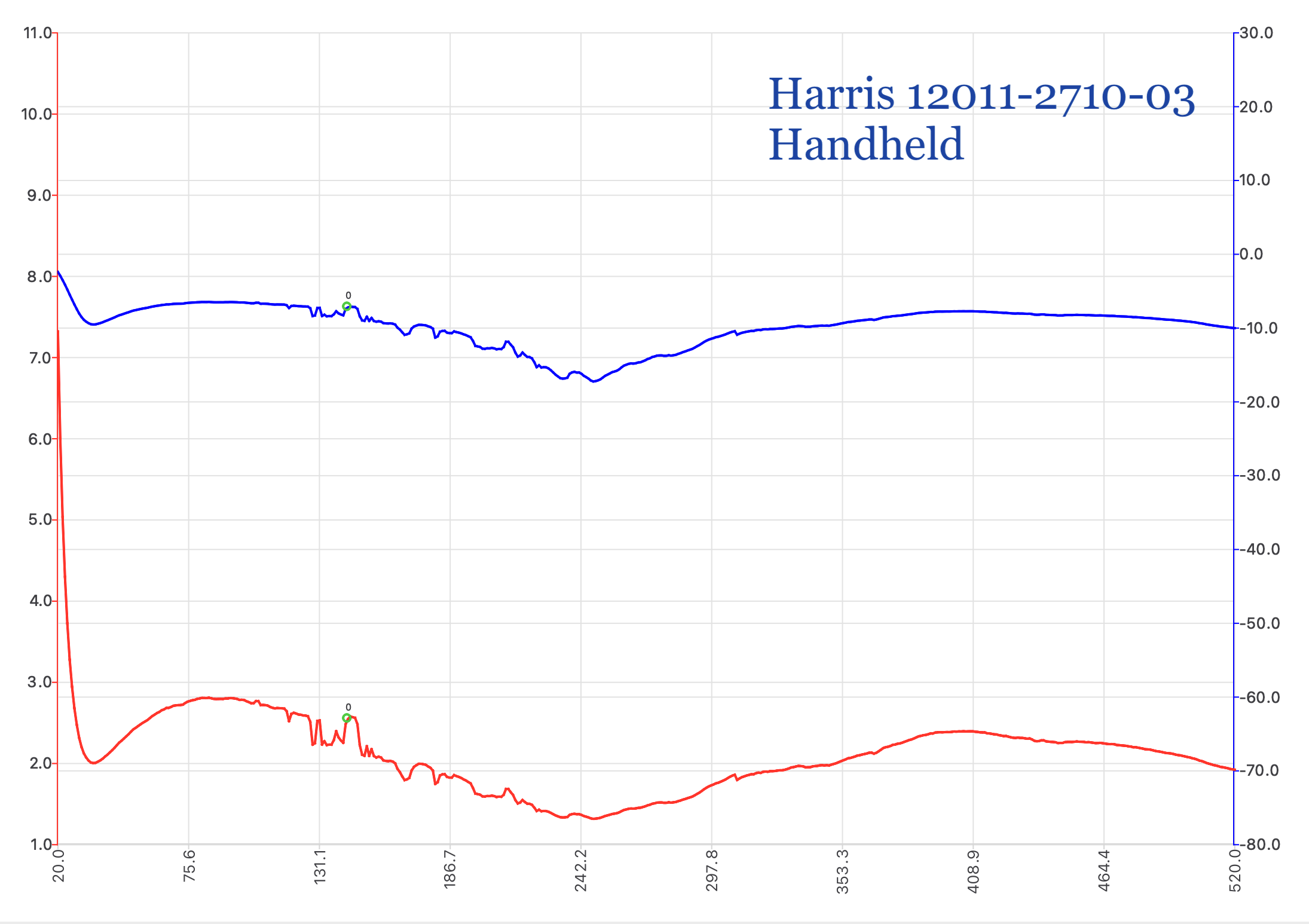
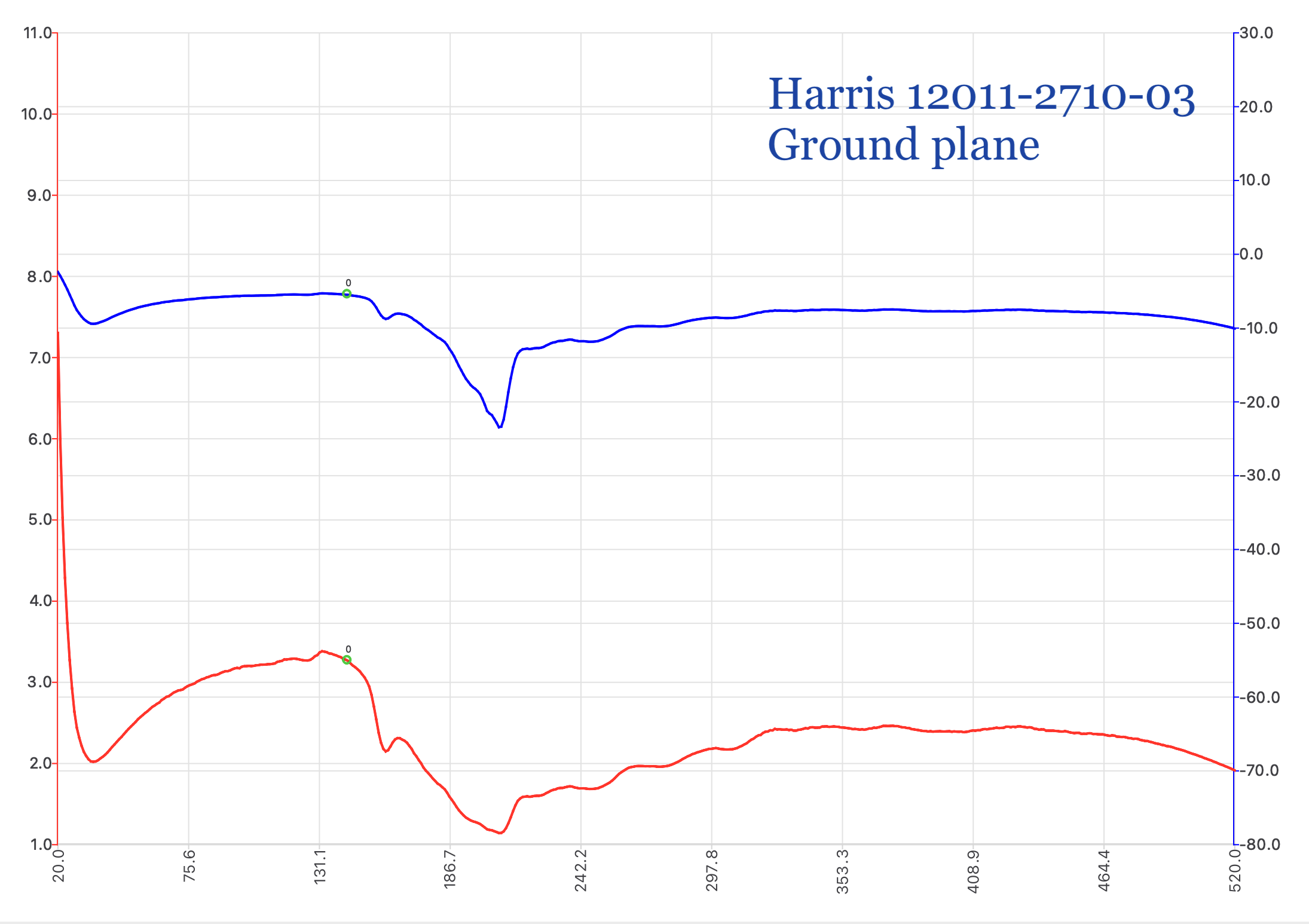
Comrod VHF30512MP/TNC
This is a legitimate military whip antenna intended for manpack radios (not really for hand helds). Comrod (🇳🇴!) is a pretty large manufacturer of various military antenna systems, in the same vein as e.g. Harris, AeroAntenna (more of an aviation manufacturer), and Radiall.
It covers the 30-512 MHz range and is not specified for gain, but has a maximum specified SWR of 3.5.
The antenna as measured drops below 3.5 SWR around 20 MHz. Further, it maintains SWR up to around 600 MHz, and in theory it might be usable for GPS L1 and 2.4 GHz Wi-fi since the SWR comes down in this range.
It is rated for an unusually high 25 W for this type of antenna – the base is quite thick, ⌀33 mm or so at the widest point.
The whip seems solidly attached (possibly held with some set screws to the matching unit) and is 1.2 meters long including the gooseneck.
SWR performance was tested using an IC-705 Windcamp cage with a custom 3D printed aluminium mounting base, giving it a slightly larger ground plane than the previous tests. This is likely on the small end but a fairly reasonable manpack simulacrum, and this is where I currently plan to leave this antenna.
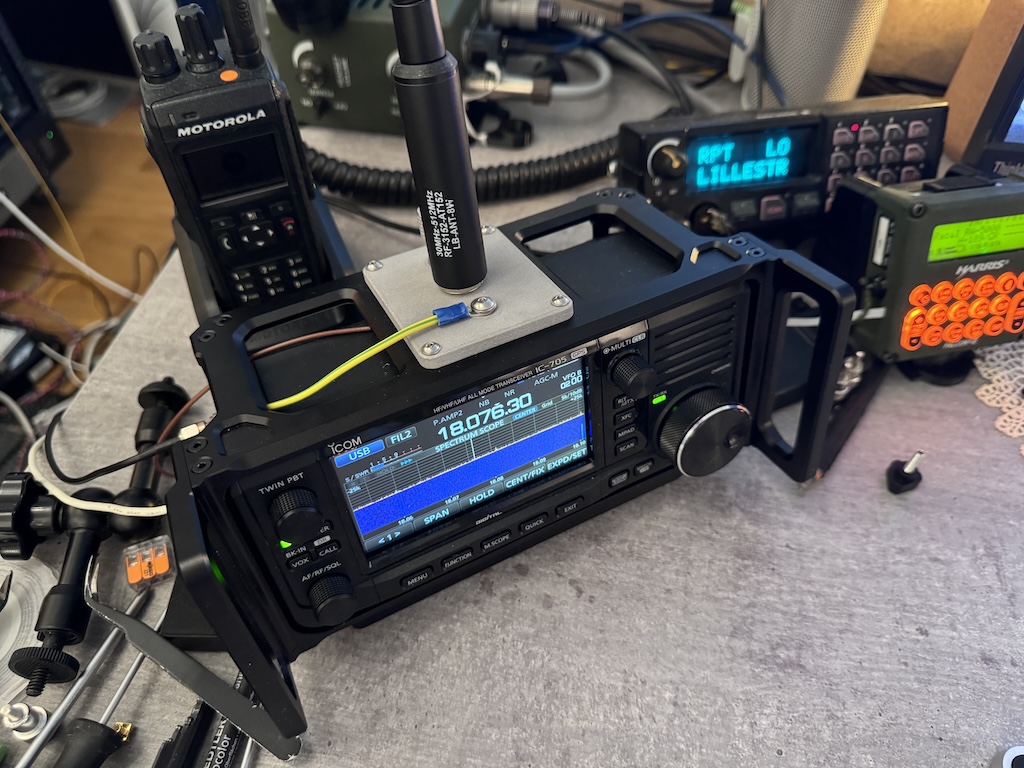
The antenna basically meets the SWR performance specification, though it has relatively large SWR ripple.
The datasheet notes that a low loss matching network is used. This is likely why we can see 3-4 distinct resonance dips across the band rather than the smoother response of a lossily matched antenna like the Harris ones shown above.
The HF performance doesn't really flatten the way a resistor-matched antenna does as shown in Appendix A, also suggesting a different network is used.
When folded the SWR plot is very sensitive to the exact orientation, and the datasheet subtly implies the antenna is only meant for use in the unfolded position, given a velcro strap apparently isn't even offered as an option. The tape section is also pretty hard to actually break for bending.
Body proximity near the base seems to slightly improve the SWR of the antenna, and this case would be typical for a body-worn use case.
Comrod VHF30512HH/L
This is the handheld variant of the above manpack antenna. The rated power is lower at 16 W, and the total length is around 80 cm instead of 120 cm. Gain is specified as –12-0 dBi, obviously dependent on installation type.
It's supplied with a velcro strap for folding, and is generally much lighter (and easier to fold). Mechanically it's a good fit for a PRC-152 type radio.
It seems to have a slightly different matching network vs. the manpack antenna with lower ripple.
Radiall MD10-004 Flexible Whip
This is an overmolded whip antenna that is available through Mouser (some other models are also in stock). It is manufactured by French manufacturer Radiall, though the country of origin is in fact Mexico.
The MD10-004 doesn't have a public datasheet but looks basically identical to the TRI PRC-152 stock whip (and the Gizont wideband mentioned below), it's a ~13" overmolded whip specified for 30-512 MHz coverage with an 8 W power rating.
Build quality is quite good, with a solid feeling. The antenna is embossed with a Radiall logo and a text reading "Antenna, Wideband, 30-512 MHz).
Testing was performed using the IC-705 ground plane, and it shows a >3 SWR across the board with >2.5 at most frequencies. The response varies a bit with body proximity, the change is primarily improved SWR at various frequencies.
We can see from the smoothness of the plot that it's probably a very lossy match, the ~2:1 SWR areas look very much like a 100 Ω resistive load. The HF response is very deep hitting 3:1 below 10 MHz.
The antenna very much meets the requirement of "low SWR wide band", I expect it'll perform about as well as the genuine Harris 13" whip. The main difference being that this whip is more floppy, while the flat blade can be collapsed but is stiffer over all.

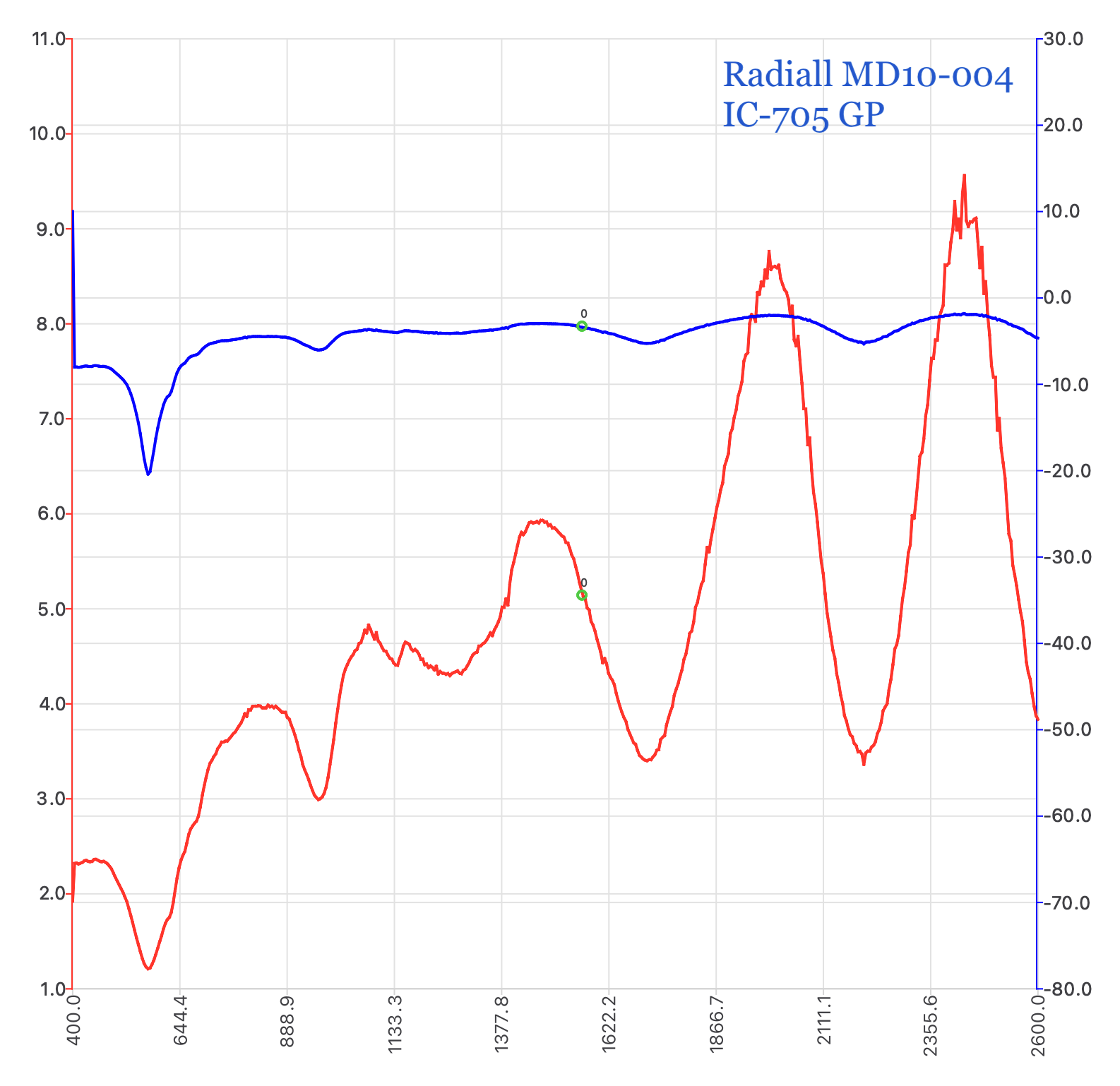
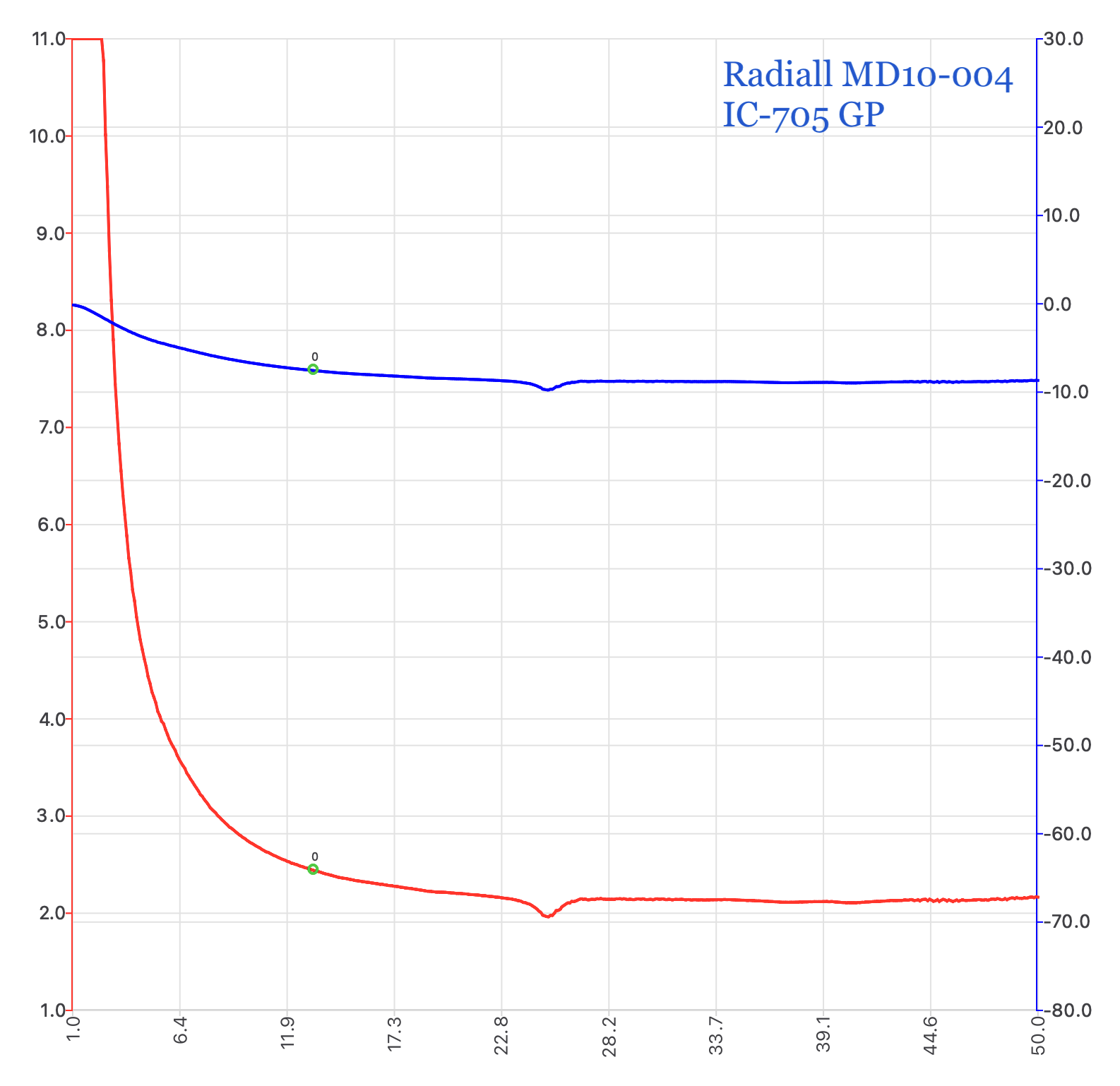
Appendix A: What's inside a wide-band military-style antenna?
I had also purchased a Gizont wideband (30-512 MHz) whip antenna but unfortunately I broke this prior to getting proper measurements.
I was however able to disassemble it and figure out the circuitry, which is relatively simple:

The circuit has an input low pass filter, which is probably not critical but not a bad idea. A set of 50 Ω load resistors make up the lossy element, and a 1:2 transformer (hooked up like an auto-transformer) makes a 1:9 un-un so a 450 Ω or so nominal output impedance.
For a shorted antenna the minimum impedance will basically be ~50 Ω to ground, and for an infinite impedance antenna the maximum load impedance then becomes ~100 Ω.
I think this a very similar circuit to what is used in the Harris knockoff and probably the genuine article as well. The bottom 50 Ω was made of two 100 Ω resistors, and relatively high power (2 or 5 W each).
